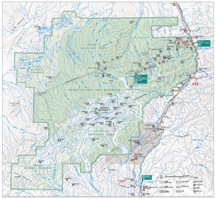Denali National Park
 Before I write anything more, let me get this out of the way: Denali National Park is overrated. There, I've said it. It may sound like sacrilege to some, but it's true. Don't get me wrong, it's not that it is not beautiful, breathtaking, humbling, and all of that, but you don't have to go into the National Park (click on the map to the left for a full-size version) to experience all these things. Instead, you could just go back down to Cantwell and take Highway 8, the "Denali Highway" and be just as in the middle of nature as you are in the park. If Mount Denali is what you are after, chances are you will not see it anyway because it makes its own, bad weather. And the only way you can get into the park is inside a very uncomfortable bus, but more on that later.
Before I write anything more, let me get this out of the way: Denali National Park is overrated. There, I've said it. It may sound like sacrilege to some, but it's true. Don't get me wrong, it's not that it is not beautiful, breathtaking, humbling, and all of that, but you don't have to go into the National Park (click on the map to the left for a full-size version) to experience all these things. Instead, you could just go back down to Cantwell and take Highway 8, the "Denali Highway" and be just as in the middle of nature as you are in the park. If Mount Denali is what you are after, chances are you will not see it anyway because it makes its own, bad weather. And the only way you can get into the park is inside a very uncomfortable bus, but more on that later.
We awoke to a most beautiful sunrise early in the morning. Rarely have I seen such a striking sunrise with deep reds across the entire eastern sky. The above picture is quite blurred, but the best I could do with my little digital camera.
We headed out towards the Denali Wilderness Access Center at the entrance to Denali National Park, from where we were scheduled to take the 7:30 a.m. shuttle bus into the park, all the way out to Fish Creek. These shuttle buses sell out quickly and should be reserved well in advance, as they are the only transportation into the park. They are converted school buses, painted green, that are not only very uncomfortable, but also offer only obstructed views&the window dividers are all helpfully at eye level. And then there are the fellow passengers, of course. Shy at first, everyone quickly gets used to each other and becomes friendly, which leads to endless joking that is not funny. "Look! Rock sheep!" You see, these sheep are not really sheep, they are merely rocks that look like sheep. Hence, rock sheep. Get it? Precious, even after 8 hours of repetition.
In the end, though, Denali is still Denali, and minor quibbles aside, it is a place of stunning grandeur. There was a mix of rain and sunshine, which led to rich contrasts and gave the place at least a semblance of scale. Spotting animals in the wilderness was everyone's first objective, and we saw some, though not many. In order of increasing ferocity: rock sheep (haha!), squirrels, goats, caribou (one), and grizzlies. I only managed to photograph grizzlies, and here are some pictures:
It was a long ride into the park in the back of an uncomfortable, hot and dusty bus, so after our turnaround, we decided to get off and hike around on our own for a while. This turned out to be an excellent choice, for once the bus had left us, we were all alone, it was quiet, and nobody was pointing out rock sheep anymore.
We went off the gravel road and into a glacial riverbed, a sidearm of the Toklat River, along which we hiked back towards the Toklat River ranger station, which we new to be only a few miles down the same river.
The sidearm of the main river clearly had a different source, as you can see in the above picture. Glacial rivers always carry lots of silt, whereas spring-fed rivers are clear. The majority of rivers in Alaska is gray, as on the right, flowing from the large glaciers in the Alaska range.
We made out way back down the river, with an incredibly strong wind at our backs. At the ranger station, we waited for a little while and caught the next shuttle bus back. Different people, same jokes. There is something universal about the human experience, isn't there?
We returned to the Wilderness Access Center around 4:30 p.m. and had dinner at a pizza place in the town that surrounds the park's entrance. I'm not aware of any name for the place, but it could rightly be called Princess Town because every business appears to be owned by Princess Cruises.
Finally, we drove the few miles back to our motel and turned in for the night, tired from a long day. The night was again fully overcast, and we could not see any northern lights.












